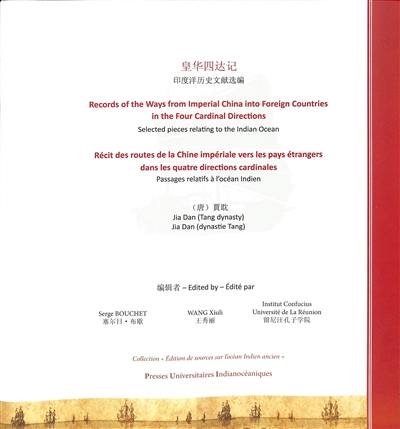
Fiche technique
Format : Broché
Nb de pages : 53 pages
Poids : 601 g
Dimensions : 25cm X 27cm
ISBN : 978-2-38444-054-2
EAN : 9782384440542
Records of the ways from imperial China into foreign countries in the four cardinal directions
selected pieces relating to the Indian Ocean
Quatrième de couverture
Au temps de la dynastie des Tang (618-907), le fonctionnaire chinois Jia Dan rassemble une collection d'informations géographiques dans son « Récit des routes de la Chine impériale vers les pays étrangers dans les quatre directions cardinales ». Au milieu du VIIIe siècle, la puissance nationale et l'influence internationale de la dynastie Tang atteignent leur apogée. L'ouvrage est confectionné alors que la Chine des Tang connaît une extension continue de son influence tant dans l'espace que sur le plan culturel. La période des Tang se caractérise par une expansion du territoire, un développement artistique et littéraire et d'importantes inventions telle l'imprimerie. Ce rayonnement explique la curiosité de Jia Dan pour les régions lointaines et sa volonté de coucher par écrit des itinéraires à partir de la Chine qui se présentent comme des cheminements de lieu en lieu indiquant les distances, les particularités géographiques.
Premier d'une série de traductions de textes chinois sur l'océan Indien ancien à paraître dans cette collection, ce recueil réunit les passages témoignant de l'intérêt de la Chine pour notre espace maritime depuis des temps reculés. Il exprime ainsi l'ouverture vers l'extérieur de la Chine à la fin du VIIIe siècle.
During the Tang dynasty (618-907), a Chinese civil servant, Jia Dan made a compilation of geographical information in his book « Records of the Ways from Imperial China into Foreign Countries in the Four Cardinal Directions ». In the mid-eighth century, the Tang Dynasty reached its peak of national power and international influence. The book was written at a time when Tang China was continuously extending her influence both spatially and culturally. The Tang period witnessed substantial territorial expansion, artistic and literary development as well as significant technical innovations, such as printing. This growth would explain Jia Dan's interest in remote regions, and his wish to put in writing itineraries, radiating from China, presenting themselves as pathways from one place to the other, specifying distances and geographical features.
This book is the first in a series of translated Chinese texts on the Ancient Indian Ocean to be published in this collection, bringing together passages demonstrating both China's interest in our maritime space since ancient times, as well as her opening up to the outside world at the end of the eighth century.





